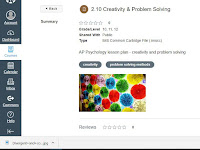What is one amazing benefit to a blended classroom? The easiest, most accessible sub plans ever! Next week, I will be attending a training on our new LMS, Canvas. According to my pacing calendar, the topic for this day is creativity and problem solving. In the past, this lesson revolved around a lot of in-class discussion; we crafted a definition of creativity, created examples of convergent and divergent thinking and discussed the TED Talk, "Do Schools Kill Creativity?" Now, since I am using a blended methodology, I do not need to lose a day or change my schedule! I just need to change my method of instruction and assessment.
 Here is an overview of what we will be doing. It appears as the student will see it in Canvas.
I embedded the activities in my description below, however; the entire lesson page has been uploaded to Canvas Commons. I LOVE the look of the page and how all of the links are embedded within the same document. If you have access to Canvas (it's free!), you can find this lesson in the Commons by searching "2.10 Creativity and Problem Solving" and import it directly into your course.
Here is an overview of what we will be doing. It appears as the student will see it in Canvas.
I embedded the activities in my description below, however; the entire lesson page has been uploaded to Canvas Commons. I LOVE the look of the page and how all of the links are embedded within the same document. If you have access to Canvas (it's free!), you can find this lesson in the Commons by searching "2.10 Creativity and Problem Solving" and import it directly into your course.
2.10 Creativity & Problem Solving
Learning Targets:
1. Identify problem-solving strategies as well as factors that influence their effectiveness
2. List and explain the importance of creative thought and creative thinkers.
3. Evaluate the impact education has on the development of creativity
Part A: Retrieval Practice - Problem-Solving Strategies:
Please access the following google form, answer the questions and submit it to me. Don't get too hung up on the riddles! Spend no more than 15 minutes on this task.
Part B: Do Schools Kill Creativity?
Watch the following TED talk and answer the following discussion questions:
** We will be using a discussion page in Canvas for their discussion. I was BLOWN AWAY by the depth and thoughtfulness of their responses to the "Memory Hackers" discussion. Seriously, every single student responded and their responses were articulate, thoughtful and demonstrated their understanding of the material. Plus, grading the discussion with the Speed Grader was a breeze! I loved hearing what each student had to say and being able to respond individually to each student.
Discussion Guidelines:
1. Submit your initial post early!
2. Respond to your peers at timely intervals. Check out the discussion board more than once so you can be an active participant in the on-going discussion.
3. Your posts should be thoughtful and encourage dialogue. Saying “good point” isn’t going to cut it. You should support your statements with examples, experiences, or references.
4 .Be brief — keep each post and response to one or two short paragraphs. Keep in mind that fellow learners will be reading and responding to you, too.
5. Stay on topic! Your posts should directly address the question, problem, or situation as presented for discussion.
6. Discussions occur when there is dialogue; therefore, you need to build upon the posts and responses of other learners to create discussion threads. Make sure to revisit the discussion forum and respond (if necessary) to what other learners have posted to your initial responses.
7. When relevant, add to the discussion by including prior knowledge, work experiences, references, web sites, resources, etc. (giving credit when appropriate).
8. Contributions to the discussions (posts and responses) should be complete and free of grammatical or structural errors. They should also be constructive in nature.
These guidelines were shared with the students at the beginning of the year and are in my course syllabus. Adapted from https://edtech.sesp.northwestern.edu/2016/02/25/4-things-to-include-on-an-onlineblended-course-syllabus/
Thank you for following my journey into blended learning. I hope you find this lesson to be of use! Please let me know if you have any questions or suggestions. I would love to hear from you. If you would like to be alerted when future posts are published, be sure to subscribe to this blog.
Cori
.jpg)




Comments
Post a Comment